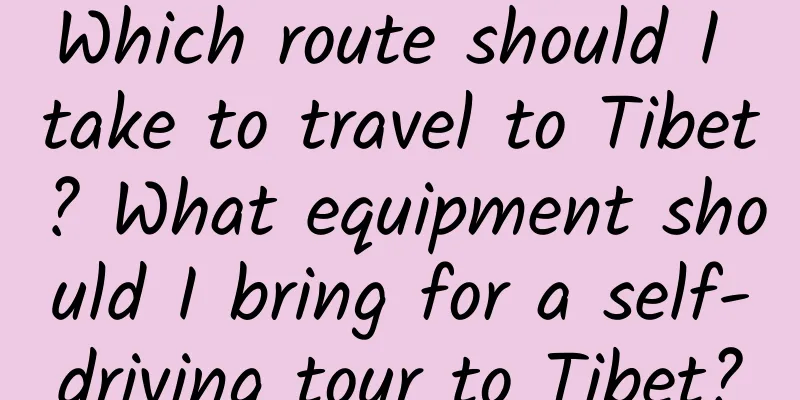Which route should I take to travel to Tibet? What equipment should I bring for a self-driving tour to Tibet?

|
It is best to go to Tibet by plane. There are flights to Lhasa. For safety reasons. If your car is good and you are interested in it, you can also drive by yourself. Since it takes a long time, it is best to have a companion and take turns driving. However, there are many places in Tibet that not every self-driving person can go deep into. Therefore, it is very necessary for friends who drive to Tibet to understand the road conditions in Tibet and master the driving skills in Tibet. So what route should you take to travel to Tibet? What equipment should you bring to Tibet for a self-driving tour? Let's take a look at the introduction of Encyclopedia Knowledge Network below! Contents of this article 1. Which route should I take to travel to Tibet? 2. What equipment should I bring for a self-driving trip to Tibet? 3. What local specialties should I buy when I go to Tibet? 1Which route should I take to travel to Tibet?1. Start from Lhasa and finally arrive in Shigatse. This is also the golden route for Tibet tourism. 2. On this tourist route, you will reach the holy land of Tibet - Lhasa, where you can see the majestic Potala Palace, the Tanggula Mountains with snow all year round, and the sparkling Namtso Lake. 3. After visiting these attractions in Lhasa, continue to Shigatse, the second largest city in Tibet, where there are also many beautiful scenery. 4. In Shigatse, you can see the splendid Tashilhunpo Monastery, the magnificent Panchen Lama's new palace, and the valley scenery where the Yarlung Zangbo River and the Nianchu River meet. At the same time, you can also visit the ancient and solemn Sakya Monastery. There are exquisite murals, mysterious thangkas and a collection of books as dense as a honeycomb. 2What equipment should I bring when traveling by car to Tibet?1. Car supplies: GPS navigator, road map, battery starter cable, spare tire, tow rope, electric air pump, inverter, shovel, engine oil, on-board tools, triangular parking warning sign, flashlight, pliers, spare car key; 2. Personal equipment: backpacks, waist bags, rain covers, tents, moisture-proof mats, sleeping bags or liners, multi-purpose knives, mountaineering watches, waterproof matches, whistles, waterproof bags, raincoats, thermos bottles, gas tanks, stoves, pot sets, cameras, tripods, spare batteries, and various chargers; 3. Clothing: Jackets or down jackets, fleece jackets, jeans, other replacement clothes according to the season, sun hats, gloves, socks, high-top hiking shoes, slippers; 4. Food: mineral water, mustard tuber, beef jerky, high-calorie snacks, compressed biscuits, instant coffee, salt, instant noodles, and other personal favorite foods; 5. Medicines: quick-acting heart-saving pills, antibacterial drugs, cold medicines, headache medicines, effervescent tablets, glucose cubes, eye drops, cooling oil, Rendan, oxygen bags and personal medicines; 6. Documents: identity card, border pass, passport, driver's license, vehicle registration certificate, payment receipts for vehicle and vessel use tax and road maintenance fee, insurance policy, travel guide book, travel itinerary, address and telephone directory. 3What local specialties should I buy when I go to Tibet?1. Thangka: a scroll painting, usually painted on silk or cloth. It is widely popular in Tibetan areas because it often depicts religious content and is easy to carry. 2. Tibetan Knife: It is a well-known traditional handicraft in Tibet with a long history and unique style; 3. Musk: It is the secretion of the glandular sac between the navel and genitals of male musk deer. It has a special fragrance and is one of the world's precious medicinal materials. 4. Saffron: Saffron can be used as medicine, which has the effect of promoting blood circulation and unblocking meridians; 5. Nyingchi Tibetan Incense: It can not only be used in Buddhist activities, but also has unique medical effects such as killing bacteria, expelling foul air, preventing colds and other epidemic diseases, and enhancing sleep. It is beneficial to the human body without any harm. |
<<: Where is the most beautiful place in Tibet? What is the travel guide for a 5-day trip to Tibet?
>>: What should I wear in Tibet in summer? How often do pilgrims kneel?
Recommend
How to feel pulse during pregnancy
Traditional Chinese medicine is a unique medical ...
How to eat bitter chrysanthemum? Do you need to blanch bitter chrysanthemum in boiling water?
The hot summer is coming soon. Today, Encyclopedi...
What is the best way to change the color of the wheel hub?
The wheels of cars are generally made of aluminum...
Will newly planted roses become stiff? How to transplant roses without stiffening them?
Roses are very common and easy to grow. I used to...
Female anus pain and bleeding
We all know that it is not easy for ordinary peop...
What to do if there are lumps under the armpits during breastfeeding
For women, the older they get, the more they shou...
Who are the high-risk groups for diabetes?
1. The high-risk group for adult diabetes refers ...
Three days before the birth of the second child
In the past, the country advocated having only on...
When will the barbershop open during the epidemic? What should I do if I need a haircut during the epidemic?
Did your hair grow wildly during the epidemic? It...
Can I still get pregnant after taking Yuting?
Birth control pills are mainly common contracepti...
Food was sold as a "magic weapon for lowering uric acid", and netizens revealed that their old father was defrauded of thousands of yuan by online shopping
Produced by | Eye Health is Real Author | Chen Zh...
What causes thirst during early pregnancy?
As the fetus grows during pregnancy, the body of ...
Can pregnant women eat peanut sprouts?
Pregnant women need to pay attention to their die...
Are cramming exercise methods VS regular exercise really equally effective?
If we were to ask what the most painful thing for...
How to treat bacterial vaginosis?
Nowadays, many women are busy with family and wor...









